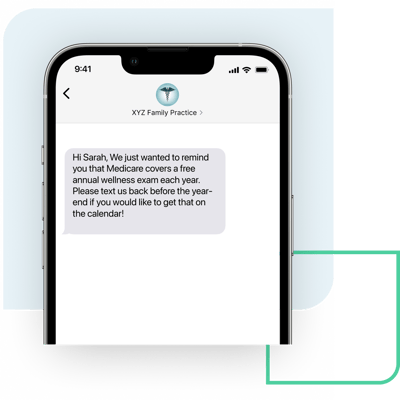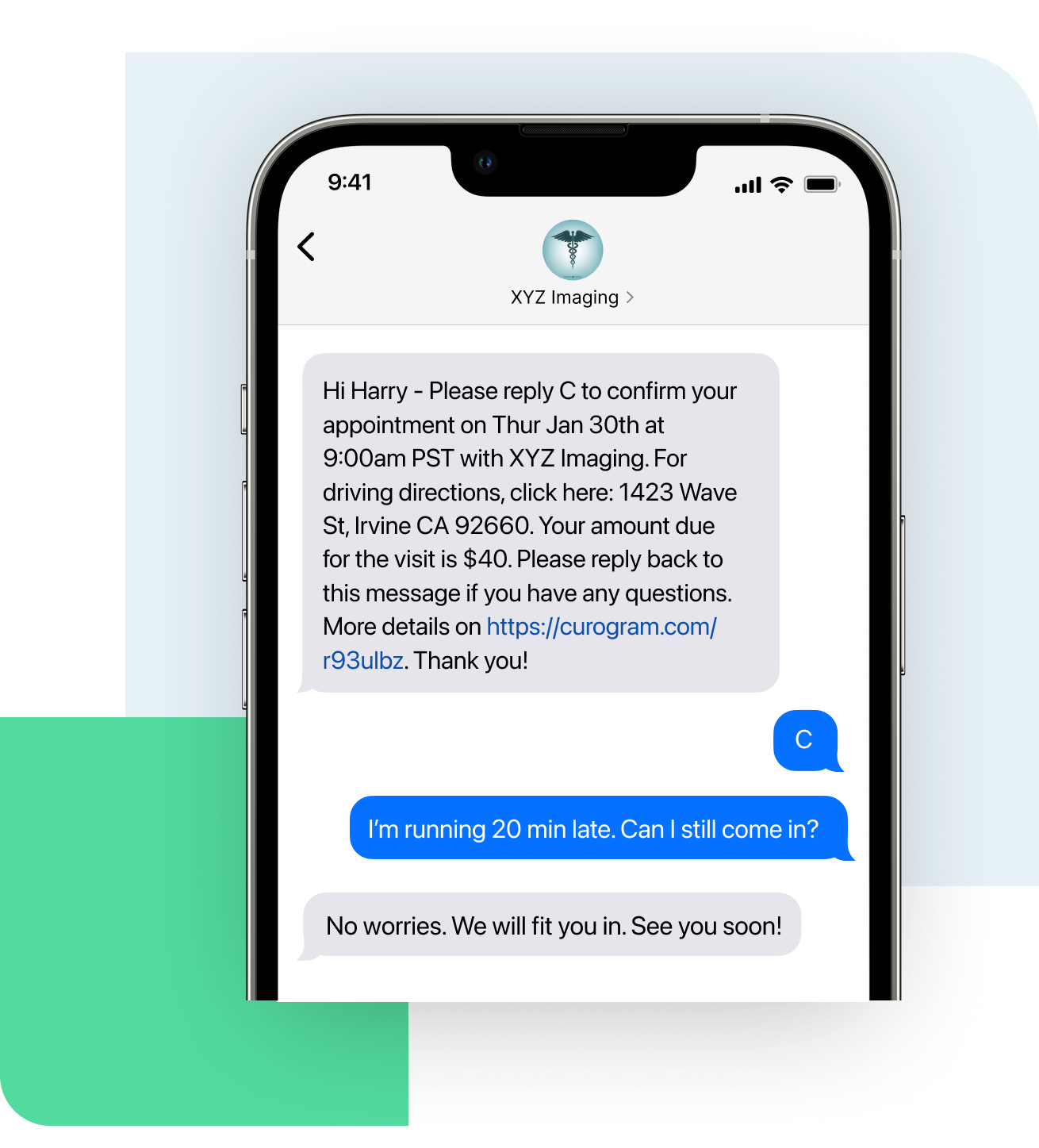HIPAA Compliant Texting for Healthcare Practices
Enhance patient communication, reduce phone calls, and streamline your front desk with our HIPAA Compliant Text Messaging App
Patients Prefer to Communicate With You Through HIPAA Compliant Texting
Curogram’s 2-Way HIPAA compliant texting platform allows healthcare practices to communicate directly with patients while ensuring security and HIPAA compliant text messaging.
With SMS texting for scheduling and administrative communication, and secure encrypted messaging for PHI and care coordination, you can reduce call volumes, increase patient satisfaction, and streamline communication for everything from appointment reminders to follow-ups—without compromising on patient confidentiality.


Features
90% of text messages are read within the first 3 minutes, while only 60% of emails are opened in the first 24 hours, and less than 20% of calls get answered today.
-
Use Your Main Office Number
Curogram's HIPAA compliant text messaging platform uses your practice's main phone number, ensuring that patients recognize who is reaching out to them. This familiarity increases response rates and builds trust. Patients are more likely to engage if they know you!
-
Auto Response After Hours
When your office is closed, Curogram’s auto-responder keeps patients informed. Set up automatic responses after business hours to let patients know their message has been received and that someone will follow up during office hours. This improves patient satisfaction and reduces frustration.
-
Secure Encrypted Messaging for PHI
Curogram’s HIPAA compliant text messaging app allows you to send Protected Health Information (PHI) via encrypted messaging with a simple identification process and without the need for annoying usernames and passwords that come with EMR patient portals. Patients often struggle with EMR portals, so our HIPAA compliant texting solution enables providers to easily send lab results and follow up on clinical issues using simple, encrypted SMS links.
-
Appointment Reminders
Keep patients informed and reduce no-shows with highly customizable automated appointment reminders sent via HIPAA compliant texting, email, and phone calls. Curogram’s HIPAA compliant texting app allows you to tailor reminders by appointment type, language, or location—making patient communication clear and relevant for every visit.
-
Mobile-Friendly Forms via SMS
Patients receive secure links via HIPAA compliant texting to complete online forms, upload documents, update insurance information, or submit health histories before appointments. This streamlines the intake process and significantly reduces check-in times, powered by Curogram’s HIPAA compliant text messaging app
Reduce Phone Call Volume by 50%
Phone calls can overwhelm staff, but with Curogram’s 2-way HIPAA compliant messaging app, patients can quickly confirm appointments, ask questions, and follow up without needing to call your office. This frees up your staff to focus on more important tasks while maintaining high levels of patient engagement.
Improve Patient Satisfaction with Texting
Patients prefer the convenience of texting over phone calls. Curogram’s real-time HIPAA compliant texting app allows your practice to provide instant communication, helping patients feel supported and informed at every step of their care.
Protect Patient Privacy and Stay Compliant
Maintaining HIPAA compliance is crucial for protecting patient privacy. Curogram’s HIPAA compliant texting platform is built with security in mind, and is SOC2 certified. Curogram does not delete any message history so you have a permanent audit trail of your patient communication.
Reduce No-Shows with 2-Way HIPAA Compliant Texting
.png?width=600&height=500&name=curogram%20(21).png)
Reducing No-Shows with Automated Text Reminders
A busy family practice uses Curogram’s HIPAA compliant texting app to send patients customized appointment reminders. This communication reduces no-show rates by 30%, improving scheduling efficiency and increasing revenue.
Streamlining Insurance and Document Collection
A pediatric clinic uses Curogram’s HIPAA compliant text messaging app to send mobile-friendly forms to request insurance card images and necessary documents before a patient’s visit. Patients can simply snap a photo and upload it securely through text, speeding up the intake process and reducing wait times.
Engaging Patients with After-Hours Auto-Responder
A multi-location clinic leverages Curogram's HIPAA compliant texting platform to auto-reply after-hours to ensure that patients who text outside of business hours receive immediate feedback. These automatic messages assure patients that their inquiry has been received, boosting satisfaction and reducing the number of follow-up calls.
Frequently Asked Questions
-
What is HIPAA compliant texting?
HIPAA compliant texting refers to secure text-based communication specifically designed for healthcare organizations to safely send and receive Protected Health Information (PHI). It is HIPAA compliant to send certain communication like appointment notifications, prescription notifications, and prep instructions via standard SMS texting, but you must encrypt messages with PHI to be HIPAA compliant in alignment with the Health Insurance Portability and Accountability Act (HIPAA). By incorporating advanced encryption, secure data storage, audit logging, and controlled access, this form of texting allows healthcare providers to communicate efficiently with patients and colleagues while fully maintaining patient privacy and regulatory compliance. Curogram offers users the ability to send both regular SMS for non-PHI healthcare communication, and secure encrypted messaging for PHI.
-
Can I communicate securely with patients via regular text messaging?
No, regular text messaging (SMS) isn’t encrypted or secure and doesn’t meet HIPAA compliance standards. Healthcare practices must use a HIPAA compliant messaging app to securely share Protected Health Information (PHI).
-
How does a HIPAA compliant texting app protect patient information?
A HIPAA compliant text messaging app protects patient information through multiple layers of security. It encrypts all messages containing Protected Health Information (PHI) during transmission and storage, ensuring that data remains unreadable to unauthorized individuals. Additionally, it employs strict user authentication, controlled access, automatic session timeouts, audit logging, and regular security monitoring. These measures collectively ensure that patient communication is secure, confidential, and always compliant with HIPAA regulations.
-
Can I use Curogram’s HIPAA compliant texting on any device?
Yes, Curogram’s HIPAA compliant texting is web-based, meaning you can securely send and receive messages from any device with an internet connection, including desktop computers, laptops, tablets, and smartphones. There’s no need to install special software or apps—simply log in from your web browser to easily communicate with patients while maintaining HIPAA compliance and keeping patient data safe.
-
Do patients need to download an app to use HIPAA compliant texting?
No, patients don’t need to download an app. They can securely receive and reply to messages directly through standard SMS or secure web links sent via HIPAA compliant text messaging.
-
Does HIPAA compliant texting help with patient satisfaction?
Yes, HIPAA compliant texting enhances patient satisfaction by providing timely, secure, and convenient communication, leading to improved patient experiences and retention.
-
Can staff within the practice securely text each other using HIPAA compliant texting?
Yes. Curogram’s HIPAA compliant texting isn’t limited to patient-provider communication; your practice’s staff can also securely message each other internally. Team members can safely send messages, discuss patient cases, coordinate care, share important updates, assign tasks, or quickly resolve issues—all while ensuring patient information stays protected. Curogram encrypts internal communications, provides detailed audit logs, and offers secure, real-time messaging, helping your practice maintain full HIPAA compliance and confidentiality.
-
Does Curogram’s HIPAA compliant texting app offer multilingual support?
Absolutely. Curogram supports multilingual HIPAA compliant texting, enabling your practice to communicate securely with diverse patient populations in their preferred language.
-
What kind of patient information can I send using HIPAA compliant text messaging?
You can securely send various types of Protected Health Information (PHI) such as appointment details, medical results, prescriptions, treatment plans, and more via HIPAA compliant texting.
-
Does Curogram’s HIPAA compliant texting app help practices comply with audits or regulatory checks?
Yes, Curogram provides comprehensive audit trails and logs, ensuring compliance and simplifying regulatory or internal audits related to patient communications.
Ready to Improve Efficiency,Patient Engagement,No Show Rates ?
Switch to Curogram’s 2-way HIPAA compliant texting platform to streamline communication and protect patient data. Request a Demo today and see how secure, real-time texting can transform your practice
